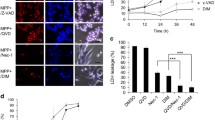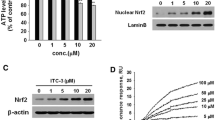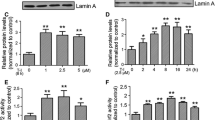Abstract
Idebenone is a coenzyme Q10 analog and an antioxidant that has been used clinically to treat Friedreich Ataxia. Being an antioxidant, idebenone could have potential therapeutic potential to treat other neurodegenerative diseases such as Parkinson’s disease in which oxidative stress plays a role in their pathogenesis. But whether idebenone can be used to treat Parkinson’s disease has not been evaluated. In this study, we found that exposure of the dopaminergic neuroblastoma SHSY-5Y cells to 1–10 μM idebenone for 72 h had no effect on the cell viability revealed by trypan blue exclusion assay and MTT assay. However, cells exposed to 25 μM or higher concentrations of idebenone showed extensive trypan blue-positive staining and significant reduction in cell viability revealed by MTT assay indicating that most of the cells were no longer viable. Idebenone-induced cell death was characterized by genomic DNA fragmentation and accumulation of cytochrome c in the cytosol indicating that the death was apoptotic in nature. In addition, idebenone induced an increase in the total RNA of the pro-apoptosis protein BAX, it also increased the caspase-3 activity in the cell lysates when compared with the untreated control cells or cells exposed to 10 μM or lower concentrations of idebenone. The detrimental effect of idebenone was attenuated by glutathione, an antioxidant, suggesting that oxidative stress contributed to the idebenone-induced cell death. In conclusion, our results suggest that antioxidant idebenone induced apoptosis when used in high concentrations.





Similar content being viewed by others
References
Artuch R, Aracil A, Mas A et al (2002) Friedreich’s ataxia: idebenone treatment in early stage patients. Neuropediatrics 33:190–193
Di Prospero NA, Baker A, Jeffries N et al (2007a) Neurological effects of high-dose idebenone in patients with Friedreich’s ataxia: a randomised, placebo-controlled trial. Lancet Neurol 6:878–886
Di Prospero NA, Sumner CJ, Penzak SR et al (2007b) Safety, tolerability, and pharmacokinetics of high-dose idebenone in patients with Friedreich ataxia. Arch Neurol 64:803–808
Gillis JC, Benefield P, McTavish D (1994) Idebenone. A review of its pharmacodynamic and pharmacokinetic properties, and therapeutic use in age-related cognitive disorders. Drugs Aging 5:133–152
Mordente A, Martorana GE, Minotti G (1998) Antioxidant properties of 2,3-dimethoxy-5-methyl-6-(10-hydroxydecyl)-1,4-benzoquinone (idebenone). Chem Res Toxicol 11:54–63
Priller J, Scherzer CR, Faber PW (1997) Frataxin gene of Friedreich’s ataxia is targeted to mitochondria. Ann Neurol 42:265–269
Strauss W (1999) Preparation of genomic DNA from mammalian tissue. Curr Protoc Neurosci A.1H.1–A.1H.3
Suno M, Nagaoka A (1989) Inhibition of brain mitochondrial swelling by idebenone. Arch Gerontol Geriatr 8:299–305
Tai KK, Truong DD (2002) Activation of adenosine triphosphate-sensitive potassium channels confers protection against rotenone-induced cell death: therapeutic implications for Parkinson’s disease. J Neurosci Res 69:559–566
Tai KK, Blondelle SE, Ostresh JM (2001) An N-methyl-d-aspartate receptor channel blocker with neuroprotective activity. Proc Natl Acad Sci 98:3519–3524
Wang CX, Song JH, Song DK (2006) Cyclin-dependent kinase-5 prevents neuronal apoptosis through ERK-mediated upregulation of Bcl-2. Cell Death Differ 13:1203–1212
Weinreb O, Mandel S, Youdim MB (2003) cDNA gene expression profile homology of antioxidants and their antiapoptotic and proapoptotic activities in human neuroblastoma cells. Faseb J 17:935–937
Acknowledgments
We thank Takeda Pharmaceuticals for providing idebenone. KKT is supported by the Long Beach Memorial Medical Center Foundation and the Parkinson’s and Movement Disorder Foundation.
Author information
Authors and Affiliations
Corresponding author
Rights and permissions
About this article
Cite this article
Tai, KK., Pham, L. & Truong, D.D. Idebenone Induces Apoptotic Cell Death in the Human Dopaminergic Neuroblastoma SHSY-5Y Cells. Neurotox Res 20, 321–328 (2011). https://doi.org/10.1007/s12640-011-9245-z
Received:
Revised:
Accepted:
Published:
Issue Date:
DOI: https://doi.org/10.1007/s12640-011-9245-z




